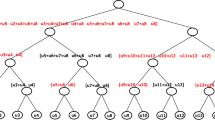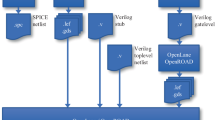Abstract
In this paper, a pseudo-natural sampling algorithm for correcting the harmonic distortion produced by asymmetric double-edge uniform-sampling pulse-width modulation is proposed. The algorithm uses the decomposability of the asymmetric double-edge pulse-width modulation process and the Lagrange numerical differentiation method for calculating the pseudo-natural sampling points to obtain a harmonic distortion correction effect. The computational complexity of the algorithm is low because it requires only three shifts, six additions and three multiplications to calculate each of the pseudo-natural sampling points. A complete experimental system based on a single field programmable gate array was built to verify the effectiveness of the proposed algorithm and to compare it with other reported kindred algorithms. The results obtained show that the proposed algorithm has lower hardware requirements and better harmonic distortion correction than other related algorithms.











Similar content being viewed by others
References
M. Abramowitz, I.A. Stegun, Handbook of Mathematical Functions (Dover, New York, 1972), pp. 875–924
V. Adrian, J.S. Chang, B.H. Gwee, A low-voltage micropower digital class-D amplifier modulator for hearing aids. IEEE Trans. Circuits Syst. I, Regul. Pap. 56(2), 337–349 (2009)
M. Berkhout, L. Dooper, Class-D audio amplifiers in mobile applications. IEEE Trans. Circuits Syst. I, Regul. Pap. 57(5), 992–1002 (2010)
H.S. Black, Modulation Theory (Van Nostrand, New York, 1953), pp. 263–281
F. Chierchie, E.E. Paolini, Real-time digital PWM with zero baseband distortion and low switching frequency. IEEE Trans. Circuits Syst. I, Regul. Pap. 60(10), 2752–2762 (2013)
P. Craven, Toward the 24 bit DAC: novel noise-shaping topologies incorporating correction for the nonlinearity in a PWM output stage. J. Audio Eng. Soc. 41(5), 291–313 (1993)
N.A. Fraser, B. Nowrouzian, A novel statistical technique for the estimation of DC stability in higher-order \( \Sigma \)-\(\Delta \) A/D converters. Circuits Syst. Signal Process. 23(6), 439–462 (2004)
J.M. Goldberg, M.B. Sandler, Pseudo-natural pulse width modulation for high accuracy digital-to-analogue conversion. Electron. Lett. 27(16), 1491–1492 (1991)
F. Guanziroli, R. Bassoli, C. Crippa, D. Devecchi, G. Nicollini, A 1 W 104 dB SNR filter-less fully-digital open-loop class D audio amplifier with EMI reduction. IEEE J. Solid-State Circuits 47(3), 686–698 (2012)
B.-H. Gwee, J.S. Chang, H. Li, A micropower low-distortion digital pulsewidth modulator for a digital class D amplifier. IEEE Trans. Circuits Syst. II, Analog Digit. Signal Process. 49(4), 245–256 (2002)
B.-H. Gwee, J.S. Chang, V. Adrian, A micropower low-distortion digital class D amplifier based on an algorithmic pulsewidth modulator, IEEE Trans. Circuits Syst. I, Regul. Pap. 52(10), 2007–2022 (2005)
M.J. Hawksford, Dynamic model-based linearization of quantized pulse-width modulation for applications in digital-to-analog conversion and digital power amplifier systems. J. Audio Eng. Soc. 40(4), 235–252 (1992)
S.W. Heo, J. Kim, Double edge trailing PWM based full digital audio amplifier design, in Proceedings of the IEEE International Conference on Consumer Electronics (2012), pp. 251–252
R.E. Hiorns, M.B. Sandler, Power digital to analogue conversion using pulse width modulation and digital signal processing. IEE Proc. G 140(5), 329–338 (1993)
J.-W. Jung, M. J. Hawksford, An oversampled digital PWM linearization technique for digital-to-analog conversion. IEEE Trans. Circuits Syst. I, Regul. Pap. 51(9), 1781–1789 (2004)
K. Kang, J. Roh, Y. Choi, H. Roh, H. Nam, S. Lee, Class-D audio amplifier using 1-bit fourth-order delta-sigma modulation. IEEE Trans. Circuits Syst. II, Express Briefs 55(8), 728–732 (2008)
J.-M. Liu, S.-H. Chien, T.-H. Kuo, A 100 W 5.1-channel digital class-D audio amplifier with single-chip design. IEEE J. Solid-State Circuits 47(6), 1344–1354 (2012)
P.H. Mellor, S.P. Leigh, B.M.G. Cheetham, Improved sampling process for a digital, pulse-width modulated class D power amplifier, in Proceedings of the Colloquium on Digital Audio Signal Processing (1991), pp. 3/1–3/5
K. Nielsen, A review and comparison of pulse width modulation (PWM) methods for analog and digital input switching power amplifiers, in Proceedings of the 102nd AES Convention (1997), preprint 4446
J. Noh, D. Lee, J.-G. Jo, C. Yoo, A class-D amplifier with pulse code modulated (PCM) digital input for digital hearing aid. IEEE J. Solid-State Circuits 48(2), 465–472 (2013)
C. Pascual, Z. Song, P.T. Krein, D.V. Sarwate, P. Midya, W.J. Roeckner, High-fidelity PWM inverter for digital audio amplification: spectral analysis, real-time DSP implementation, and results. IEEE Trans. Power Electron. 18(1), 473–485 (2003)
J. Peng, J. Wang, S. Tan, Optimal FIR filter design based on curve fitting approximation for uncertain 2–1 sigma-delta modulator. Circuits Syst. Signal Process. 33(3), 885–894 (2014)
Z. Song, D.V. Sarwate, The frequency spectrum of pulse width modulated signals. Signal Process. 83(10), 2227–2258 (2003)
K.P. Sozanski, A digital click modulator for a class-D audio power amplifier, in Proceedings of the Signal Processing: Algorithms, Architectures, Arrangements, and Applications Conference (2009), pp. 121–126
L. Stefanazzi, A.R. Oliva, E.E. Paolini, Alias-free digital click modulator. IEEE Trans. Ind. Informat. 9(2), 1074–1083 (2013)
K. Tsakalis, N. Vlassopoulos, G. Lentaris, D. Reisis, A control-theoretic approach for efficient design of filters in DAC and digital audio amplifiers. Circuits Syst. Signal Process. 30(2), 421–438 (2011)
M. Wang, X. Jiang, J. Song, T.L. Brooks, A 120 dB dynamic range 400 mW class-D speaker driver with fourth-order PWM modulator. IEEE J. Solid-State Circuits 45(8), 1427–1435 (2010)
S.-H. Yu, J.-S. Hu, Stability and performance of single-bit sigma-delta modulators operated in quasi-sliding mode. Circuits Syst. Signal Process. 25(5), 571–590 (2006)
Z. Yu, H. Feng, A method of error correction for digital class D power amplifier, in Proceedings of the Asia Pacific Conference on Postgraduate Research in Microelectronics & Electronics (2009), pp. 153–156
Acknowledgments
This work is supported by the Science and Technology Research and Development Program of Shaanxi Province (Grant No. 2012K06-10) and the Natural Science Foundation of Shaanxi Province (Grant No. 2013JQ8039).
Author information
Authors and Affiliations
Corresponding author
Rights and permissions
About this article
Cite this article
Yu, Z., Fan, Y., Shi, L. et al. A Pseudo-Natural Sampling Algorithm for Low-Cost Low-Distortion Asymmetric Double-Edge PWM Modulators. Circuits Syst Signal Process 34, 831–849 (2015). https://doi.org/10.1007/s00034-014-9877-3
Received:
Revised:
Accepted:
Published:
Issue Date:
DOI: https://doi.org/10.1007/s00034-014-9877-3




